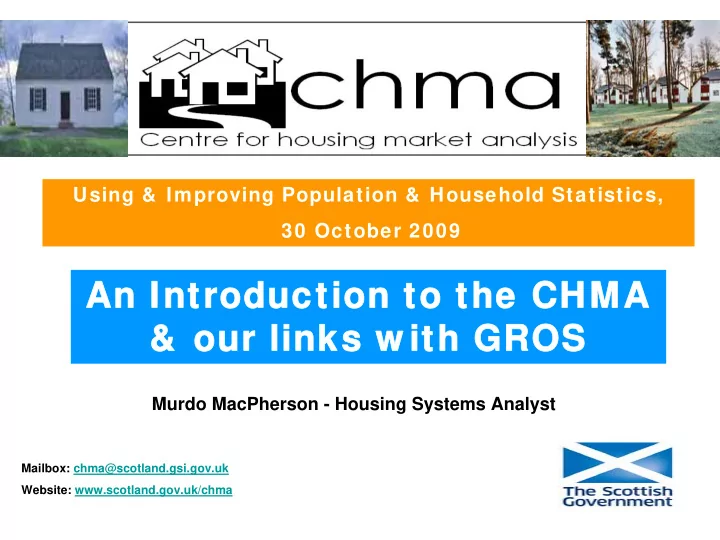

Using & Improving Population & Household Statistics, 30 October 2009 An Introduction to the CHMA An Introduction to the CHMA & our links w ith GROS & our links w ith GROS Murdo MacPherson - Housing Systems Analyst Mailbox: chma@scotland.gsi.gov.uk Website: www.scotland.gov.uk/chma
THE CHMA TEAM THE CHMA TEAM • Andy Park:– Senior Economic Advisor • Murdo MacPherson:– Housing Systems Analyst • Charles Brown:– Assistant Statistician • Strong links with GROS who advise us on population/household estimates & projections
WHY DO CHMA EXIST? • CHMA was born out of Firm Foundations (2008) • This aims to increase housing supply across Scotland • By reform of housing/planning delivery framework for local government. There are three main components: 1. Housing Need & Demand Assessments (new) 2. Local Housing Strategy (re-vamped) 3. Development Plans (re-vamped) • CHMA helps local authorities (and others) deliver this framework, particularly the housing need & demand assessments – which is heavily statistical
WHAT’S AN HNDA? WHAT’S AN HNDA? A Housing Need & Demand Assessment (HNDA) is the evidence-base which LAs will use to help them decide: - how many houses to build, - what type of houses to build, - where to builds their houses. • LAs are encouraged to follow the SG HNDA Guidance • Some LAs are doing HNDAs in-house, others contract out • HNDAs rely heavily on the use of household & population estimates and projections. CHMA & GROS advise on this.
HNDA: Population Estimates • Local population shapes the past and current structure of housing markets. • Mid-year population trends are used to indicate: - population growth/decline (volume of housing need) - age structure of population (types of housing need) - migration in/out of areas (volume of housing need) • Used to show the local housing market context before LAs go on to calculate current & future levels of housing need.
HNDA: Population Projections • Future population profile shapes the future structure of local housing markets. • Population projections are used to indicate: - future growth/decline (long-term volume of housing needed) - future age structure (long-term types of housing needed) - future migration (long-term volume of housing need) • Principle and high migration projections used to show a possible range in the volume and types of the housing need.
HNDA: Household Estimates HNDA: Household Estimates • Populations may decline but household numbers may grow, because households in general are getting smaller. • Household estimates are used to indicate past and current trends in: - household growth/decline (volume of housing need) - age structure of households (types of housing need) • Projected change in household numbers (future level of housing need) • Projected change in household composition (future type of housing needed) • Used to show the local housing market context before LAs go on to calculate current & future levels of housing need.
HNDA: Calculating Housing Need HNDA: Calculating Housing Need • HNDAs require LAs to calculate what their level of current and future housing need might be. • The calculation has 4 components including: - level of current housing need - level of future housing need - level of current affordable housing supply - level of future affordable housing supply
Calculating housing need Calculating housing need • To calculate the level of future housing supply: - HNDAs require authorities to estimate the number of newly-forming households who will require housing - GROS projections only show the net change in household numbers but do not show the number of newly-forming households. - This figure can be derived by applying household formation rates to household projections (e.g.Bramley).
Calculating housing need Calculating housing need • Having arrived at a figure for current and future housing need, LA are asked to express this as a range . • The calculation can be re-run using a variety of scenarios - one of which is principle and high migration projections.
Main Data Gaps Identified Main Data Gaps Identified 1. Small area population/ household projections especially for rural LAs (Popgroup & Housegroup software OK but not below certain threshold <10,000 population) 2. Gross household formation, number of newly formed households (GROS currently producing experimental estimates with advice from Prof. Glen Bramley)
Questions & Discussion 1. Are you using population/household estimates & projections? For what? 2. Have you identified any gaps in the data? 3. How can GROS/CHMA best address these? 4. Any questions for CHMA? Any questions for GROS? ANY THOUGHTS ON ABOVE - PLEASE KEEP IN TOUCH!!!!!
Recommend
More recommend